Post-Merger Integration: What Makes Mergers Work?
Only half of all M&A activity improves shareholder returns. Here's how to maximize your chances for success.
(originally published by Booz & Company)Mergers and acquisitions are fast becoming essential elements of corporate strategy. The worldwide value of mergers and acquisitions announced in 1998 pushed the $2.5 trillion mark - more than 50 percent higher than the previous year - and activity for 1999 is also brisk. Yet recent research shows that only about half of these merged companies have succeeded relative to peers, and despite a growing body of experience, the success rate is not improving. Still, a handful of companies have demonstrated that high levels of success can indeed be achieved on a repeated basis - success that shows in superior overall performance.
The Booz-Allen & Hamilton "Best Deals" study identifies the key strategies and best practices used by leading companies during strategy formulation, pre-merger planning and post-merger implementation that helped them achieve higher levels of success in their mergers and acquisitions. The process is not an easy one, though. Our findings show that mergers represent a challenging and risky strategic decision. The decision to merge should be fully challenged before companies decide to go ahead, particularly given the average performance of the returns and the risk associated with the potential outcomes. Even with thoughtful planning and preparation, best practices and focus, success is not guaranteed. However, applying the best practices should enhance the chances of success and help avoid catastrophic pitfalls.
Risky Proposition: Creating Value Through Mergers
Our research tested, as did many studies before it, some key variables believed in conventional wisdom to have an impact on the success of mergers. In our "Best Deals" study, we combed through the 117 most significant deals closed between January 1, 1994 and July 30, 1996 for which we could establish clear, value-based metrics. We looked at numerous factors such as industry groups, premium paid, vertical/horizontal mergers, size ratios (market capitalization and ales) and time to complete deals.
What did we find? Our analysis identified no statistically significant factor that could predict success or failure as defined by shareholder value creation relative to industry peers. The study found a high level of variability associated with potential returns. More startling, perhaps, our study produced the counterintuitive finding that purchase premium is not a predictor of success.
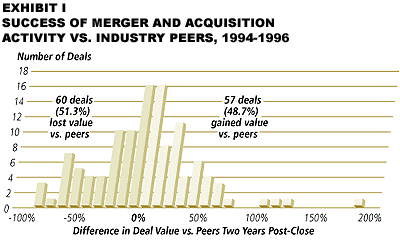
Still, trends did emerge. First, the study showed a wide range of performance by companies engaged in significant transactions, highlighting the risk. We found that one-sixth of the companies increased shareholder value by more than 44 percent over industry peers, while another sixth lost more than 44 percent versus industry peers. (See Exhibit I.) Additionally, half of all mergers failed to deliver excess returns: 51.3 percent underperformed relative to industry peers.
Given the average chance of success and the wide variance in potential outcomes, it is vital that boards, management and shareholders fully appreciate the risks and rewards prior to any merger. Before starting down this risky path, it is important to consider whether it is the best strategic option and the optimal use of capital, given the traditional investment performance and the significant complexity associated with a merger.
Handicapping the Odds of Success
Are there key variables that serve as indicators or predictors of a deal's success? Our research enabled us to examine dozens of possible correlations. In particular, we looked at three variables: the purchase premium paid by the acquirer; the relative size of the acquirer and the acquiree, and the overlap (or lack thereof) in the businesses in which the acquirer and acquiree compete.
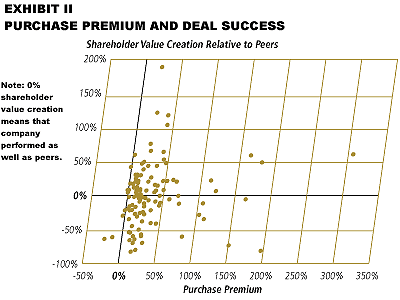
1. Correlation of Purchase Premiums. Our study showed that the purchase premium paid is not correlated to the deal's success. (See Exhibit II.) In other words, companies hat paid very high premiums did no worse than companies that paid small premiums, or in some cases, no premiums at all. The reason is that companies that were successful in mergers and acquisitions were able to create value an order of magnitude greater than the purchase premium they paid.

Exhibit III shows the companies in our "Best Deals" study that performed the best in percentage terms relative to their peers. Note that in some cases the purchase premium paid was very high as a percentage of target market capitalization. However, the value created in dollar terms was even higher. These companies realized that the merger was one step in a path to achieve a vision for their company in the long run. While the companies did not want to pay any more than they would have to in a well-played negotiation, they knew that the additional premium was justifiable relative to the value they observed in the potential merger.
Two deals illustrate this point well. In May 1995, the Williams Companies paid a 307 percent premium (the largest in our database) for the Transco Energy Company, creating the nation's largest volume natural gas pipeline system. Transco is the largest of the five interstate pipeline systems owned by Williams.
While analysts were cool to the deal, Williams saw the real value in investing in Transco's equipment and having access to the valuable Eastern United States market. Wall Street immediately took more than $250 million - more than 10 percent - off Williams' market value, leaving the stock at $25 a share, 25 percent below its 1994 high when the deal was announced (in late 1994). Meanwhile, Transco had been struggling under a heavy debt load that was incurred in settling poorly priced gas contracts in the mid-1980's. Williams had capital to invest, having just sold its Wiltel Network Services unit to LDDS Communications (now known as MCI Worldcom) for about $1.6 billion after tax. Williams' strategic vision, coupled with its ability to manage the significant change inherent in a merger, enabled the Williams/Transco entity to outperform industry peers by 62 percent and create more than $4.7 billion in additional value.
The deal between Tyco International Ltd., a diversified manufacturing and service company, and Kendall International Inc. in October 1994 is another example of a merger with a noteworthy premium that created significant shareholder value. At the time, Tyco's most important lines of disposable products were used in hospitals and nursing homes. These included single-use electrodes for electrocardiographs, blood bags, intravenous bags, etc. Tyco already had about $100 million in such business and had decided it wanted more. In 1994, therefore, Tyco bought Kendall, a market leader in disposable medical products. At a 39 percent premium it was also considered too rich by Wall Street, which underestimated Tyco's ability to build businesses and the evel of complementarity between the two companies' capabilities. A July 1994 article in USA Today written a few weeks after the deal was announced characterized it as one that showed "naïveté about refusals to pay too much and making 'pure strategic fits' in a deal that may or may not be synergistic." Tyco's stock price dropped almost 10 percent in the ensuing weeks. However, Tyco had a vision. It knew that the Kendall management team and capabilities could be a strong foundation for growing the disposable medical products business. It added four subsequent acquisitions, and the division that was started with the Kendall acquisition is now at $3.4 billion in sales versus about $100 million for Tyco originally. In this example, more than $3.1 billion in market value was created.
2. A Question of Relative Size. Another factor we examined was the relative size of the acquirer and target company to determine if some approaches, such as acquiring small companies, were more productive than others. Our analysis compared acquirer to target in terms of market capitalization and sales, and the absolute size of the acquirer, to see if any excess returns existed. No excess returns were found. (See Exhibit IV.)
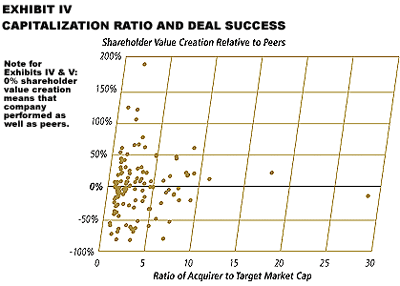
3. Industry Similarity. Finally, we examined whether excess returns were derived from the type of merger created using several different methods. We found no excess returns for vertical (different industry) or horizontal (similar industry) mergers. For example, industry similarity between the two partners in the deal, as measured by similarity in primary SIC code, showed no significant correlation and very wide variances. (See Exhibit V.) Some, such as USA Waste Services' acquisition of Western Waste Industries, were horizontal mergers driven by consolidation; that deal delivered 66 percent in excess return. Conversely, other companies used acquisitions in different but related industries to advance their strategies. An example is the Tosco Corporation's acquisition of the Circle K Corporation, which allowed Tosco to outperform peers by 65 percent. Circle K, now the marketing division of Tosco, is the largest operator of company-owned convenience stores in the United States.
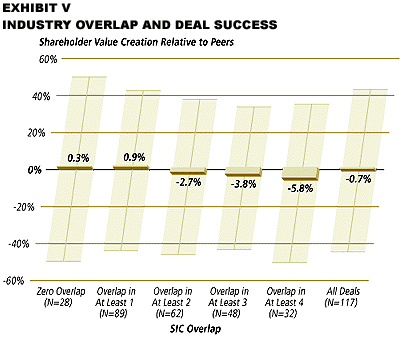
How to Increase the Odds of Success
So if these simple measures give us no clues about why some companies do better than others, how can we draw conclusions? In order to understand why certain companies are able to achieve higher returns, we looked behind the scenes to study the details of what they did - beyond the simple measurements and into the complex texture of their merger and acquisition process.
In addition to the "Best Deals" study, we tapped into the findings of our 1997 study entitled, "Making Acquisition Work: Capturing the Value of the Deal." This examined a sample of 35 companies worldwide that are active in mergers and acquisitions and examined the use of 100 tactics to discern the differences between those that were successful and those that were not.
How can a company increase the odds? Our combined research shows that the most successful companies link effective strategic formulation, pre-merger planning and post-merger integration. (See Exhibit VI.) Having all three components is critical for success:
- A vision, strategically formulated, for where the company is going and how the deal fits. Companies then identify the appropriate targets and get the deal done.
- A pre-merger process that targets companies with the right capabilities, gets the deal done and begins the integration through rigorous planning and building of trust among the players.
- A post-merger process that seeks to capture well-defined sources of value and is led in a way that captures as much value as possible as quickly as possible.

Addressing the Challenge of Strategic Leadership
There are many reasons why a company may choose to merge. Much of the deal activity of recent years has been driven by strategic reasons such as consolidation; convergence across technologies and/or industries; technology control and management (easier to buy than build, defensive maneuver); geographic expansion, or new distribution and/or cross-selling opportunities. In many instances, mergers have helped define fundamental changes in a given industry (the British Petroleum Company/the Amoco Corporation) or across industries (AT&T/Tele-Communications Inc.).
Once an industry deal is initiated, many other companies often are driven into the merger game to compete on the same scale. Many companies are driven by urgency to buy rather than to be bought; to buy because it seems faster than to build, or to buy because the pace of business is simply too fast to be slow adding capabilities. The problem then is that all too often companies view the merger itself as the strategic end game. This is particularly true in consolidating industries such as banking, where every company seems to be competing just to get big. But successful companies understand that the deal is a means to an end and not an end in itself. In fact, in many cases, the deal will be the first of several that piece together the needed capabilities to achieve the vision.
Our research into corporate growth (see, for example, "Toward a New Theory of Growth" in Issue 2, or "10X Value: The Engine Powering Long-Term Shareholder Returns" in ssue 8) shows that the fastest growing companies look at mergers and acquisitions as part of an overall strategy to roll out their expertise. Many of these fastest growing companies are able to produce strategic or product/process innovations internally and then use acquisitions as a way to roll out that innovation across new markets or geographies. An example of this is Newell Rubbermaid, which has used acquisitions to spread its management philosophy and manufacturing, distribution and sales expertise across a wide variety of product categories. Newell Rubbermaid manufactures and markets high-volume consumer products, including housewares, home furnishings, office products, and hardware and tools.
Checking the Completeness of the Vision
Companies rarely go into an acquisition thinking that they do not have a vision. Here is how to tell if it is real:
- Does it include a plan for disrupting the market or changing the rules of the game in the industry?
- Does it consider the competitive environment at all?
- Does it include a series of steps to get from here to there, one of which happens to be a merger or acquisition?
- Does the merger or acquisition target understand and agree with the overall combined company vision and its role in achieving it?
- Are there leaders in place who believe in the vision and are ready to help carry it out?
The vision should be a robust view of the future state of a given industry or set of industries. It should be based on the dynamic changes in the key forces of a given industry and not be merely an extension of given business plans, adjusted for inflation. A view of the future environment will help companies evaluate existing capabilities and provide an understanding of where a potential merger could serve to meet the strategy. In many instances, significant mergers have a fundamental, industry-altering impact on a company and its key competitors.
Acquisitions and alliances are two alternatives to building the capabilities needed for companies to drive toward a vision. If an acquisition is called for, it is critical that this original vision be kept in the forefront while companies plan and execute the merger. It should drive the strategic intent of the merger and the priorities of the integration process.
Finally, the merger will work best if both companies agree on the vision for the overall company going forward and where the acquisition fits into that vision. Most of the top-performing companies with which we spoke cited agreement on vision as a critical factor in the success of the deal and the ultimate strategy.
Again, look at Tyco's purchase of Kendall. Tyco's overall corporate vision was to dominate the four businesses in which it was engaged. It held a small position in the disposable medical products business and needed to dramatically build its capabilities if it ever hoped to dominate the business. The Kendall deal was the first of four acquisitions in this market that eventually gave Tyco what it needed to succeed. Tyco management knew where Kendall fit and was able to convince Kendall management of the same.
Unfortunately, for many companies, the vision and true strategy work is begun after the acquisition. Too often the transaction focuses on the numbers without regard to the hard work of creating market-disrupting strategies. The result is an underperforming merger.
Pre-Merger Dance
Once the vision is set and an acquisition is determined to be a potential path, companies must begin the evaluation process. Successful companies have a good understanding of what they are seeking. Because the whole transaction path started at the point of fulfilling the company's vision by buying capabilities, the company knows what capabilities it needs and understands the long-run value of having these capabilities in hand. From that list of capabilities they are able to methodically screen and evaluate potential targets. Evaluating strategic, financial and capability measures, they are able to select a potential candidate. Further, they need to structure the appropriate deal, come to a "good" price and create the optimal alliance.
Due diligence is handled in a workmanlike fashion. The two companies move down two paths simultaneously. First, they want to make sure they uncover anything that would stand in the way of doing the deal. Is the accounting sound? Are the assets and capabilities they would acquire of the quality they expect? What is the culture of the target and how well would it fit? Are there any employment contracts or other obligations pending? Companies blinded by the desire to complete a deal may well be stung later if they fail to complete their objective due diligence.
Nevertheless, the second path is the heart of pre-merger planning. The companies need to collect the data that will allow them to measure exactly the source of value from the transaction. What additional revenue can they expect? Where will they be able to cut costs? What capabilities will they acquire (expected and unexpected) on which they can build? What will they sell off? When will this all happen? How much will it cost to complete?
The best companies plan at a very detailed level in this step. They know what value is there and when they will get it. They build the cash flows and timing into a model that helps them value the deal. Then, that model becomes the action plan and scorecard for the post-merger integration. Additionally, this helps them take action quickly after the close. Several of the top performers in the "Best Deals" study reported setting detailed plans in this step that were then used as tight guidelines during integration. While they admitted that it was rare that they achieved their exact plan, they were very clear in stating that without the plan they would never have achieved their goals.
Capturing Value from Different Sources
Value capture can be derived from several key sources, and depending upon the circumstances of the merger, some will be more valuable than others. As an example, the following areas are generally useful to consider when identifying sources of value:
Growth-oriented
- New products, service offerings, markets, customer segments, distribution channels
- Enhanced market presence, market capture
- Enhanced product development efficiency (leveraged R&D, internal best practices)
- Combined technologies or capabilities
- Leveraged sales force
- Increased capture of the value chain
Efficiency-oriented
- Integrated supply chain
- Leverage procurement volume (product and non-product)
- Production footprint optimization
- Facility optimization
- Vertical integration, de-integration
- Distribution channel optimization
- Sales force optimization
- Headquarters consolidation
- Support function consolidation (human resources, finance, I.T.)
Other
- Financial value (balance sheet items, taxes, etc.)
- Optimized programs and policies (e.g., benefits programs)
- Rationalization and/or elimination of special programs, projects, etc.
- Additional alliances or relationships.
In addition to considering the full range of value options, successful companies know how to use the pre-merger process to speed value capture. This allows them to improve cash flow, stem investors' and other stakeholders' fears and move on with the other elements of the plan to achieve their vision. One company, for example, used a secure intranet system housed by a third party to begin defining and collecting benchmarking information about the two companies before the close of the deal. By working together to define the benchmarks, the two sides built trust. By using the secure intranet connection to collect and store data, they were able to move after the close with speed and decisiveness.
After the Deal, the Real Work Begins
In our "Making Post-Merger Integration Work" study we tested more than 100 post-merger activities and sifted through them to identify the 60 best-practice elements that statistically explain why the successful companies succeed. Success was achieved when companies brought together the three dimensions of achieving lasting change: vision, architecture and leadership. (See Exhibit VII.)
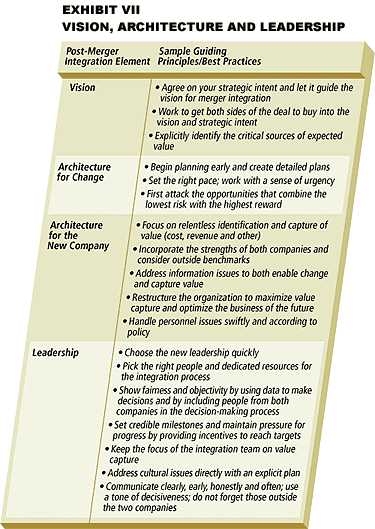
In our work with clients we have also noticed that the most successful companies retain sufficient "open architecture" thinking to identify "unanticipated" value during the post- merger process. They also exhibit an aggressiveness that allows them to capture value more quickly. We have worked with several companies thave been able to capture at least double the expected immediate value because they were open and aggressive in the way they searched for value opportunities.
Bringing it all Together
Finally, there is the need to bring each of these steps together into a coherent process. In our "Best Deals" study, we found that some of the most successful companies pinned part of their success on creating teams of people to work from the beginning on each stage: vision setting; pre-merger targeting; negotiation and planning, and final integration. In this way they were able to keep vision at the forefront, know where the value would come from and therefore negotiate the right price, and then use that understanding to guide the post-merger integration process.
The leadership of that process and the ongoing company is also critical. In most of the successful companies, leaders from both companies were involved in the process, and in many the target company's leadership stayed on to run the new combined business.
Evaluating potential mergers remains one of the most strategic and essential roles of boards and senior management. The implications of action, or inaction, can measurably enhance or erode significant shareholder value. Therefore, it is essential to "do it right." In many instances, this can mean walking away from a deal. In others, it means fully testing the assumptions of the merger and critically evaluating the organization's ability to effectively complete the integration and to create a new, more profitable entity. Given the risky and challenging nature of mergers, the burden of proof should be on demonstrating how a potential merger is the best strategic option facing the company. There must be a good answer to the question, "Why do we have to merge to achieve our vision?"
Simply put, the entire merger process can fully challenge and captivate management. The merger process encapsulates the most challenging aspects of running a company, and it increases the implications for key decisions while compressing them into a shorter time. It is important to realize the potential mergers can provide a company and the capabilities it needs to achieve its vision. It can be a powerful catalyst to help a company implement an industry-altering strategy. Likewise, a poorly conceived or implemented merger can destroy value and/or disadvantage a company relative to its competitors. It is our view that enough experience exists to significantly increase the success rate of deals. Some companies have already established this process as a core capability. In summary, by combining three steps into a coherent process - having a clear vision, engaging fully in the pre-merger process and enacting a complete post-merger process - you increase the odds of success. ![]()
Reprint No. 99404
| Authors
Albert J. Viscio, Albert J. Viscio is vice president of Booz-Allen. He is co-founder of the company's Organization and Strategic Leadership Practice, which is concerned with top management, organization, business model transformation and leadership issues. Mr. Viscio holds a B.A. in economics from Holy Cross College and a Ph.D. in economics from New York University. Mr. Pasternack and Dr. Viscio are authors of "The Centerless Corporation" (Simon & Schuster, 1998). John R. Harbison, John R. Harbison, vice president for Booz-Allen & Hamilton based in Los Angeles, specializes in strategic alliances, acquisitions and post-merger integration. Amy Asin, asin_amy@bah.com Amy Asin is a principal with Booz-Allen & Hamilton based in San Francisco. She plays a leadership role in identifying trends and best practices in post-merger integration. Richard P. Vitaro, Richard P. Vitaro is a senior associate in the Cleveland office of Booz-Allen. He has worked across more than 10 industries, assisting clients in strategic and operational issues. Mr. Vitaro received a B.S. from the United States Naval Academy and an M.B.A. with honors from the University of Chicago. |


